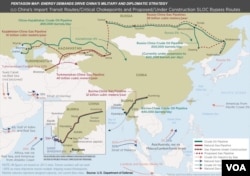China said its controversial and extensive buildup of islands and reefs in the South China Sea is no different than other public construction projects, such as the repairing of roads and building of bridges and apartments.
The question over who owns remote islands and reefs in the South China Sea has been a source of growing tension among China, the Philippines, Vietnam the United States and other countries in recent years.
But the territorial dispute has deepened in recent weeks following evidence that China has massive land reclamation projects that appear to be building up military installations in the disputed waters.
Defense Ministry spokesman Yang Yujun told reporters Tuesday that from his perspective, that has nothing to do with China’s actions or behavior in the South China Sea.
Instead, Yang said, it is the deliberate manipulation of the issue by others that has turned the issue into a controversy.
'Exaggerated concerns'
Yang said one of the reasons for this is that “some are trying to damage the reputation of China’s military and deliberately exaggerate concerns about stability in the region.” He added that one “cannot rule out the possibility that some countries are doing this to create an excuse for possible actions that they might take in the future.”
Yang was responding to questions from reporters Tuesday at a briefing on the release of the defense white paper, entitled China’s Military Strategy.
Yang did not say which countries he was referring to or what type of actions he was implying they might take, but it was clear that his comments were a direct reference to the United States.
U.S. surveillance flights near the group of islands that China is developing show scores of ships involved in land reclamation efforts, and airstrips, air traffic control towers and other possible military-related structures under development.
Last week, a CNN reporter and cameraman were given exclusive access to a U.S. military surveillance flight in the region. While on board the P-8 Poseidon surveillance aircraft the Chinese navy issued warnings for the plane to depart as it flew near Fiery Cross Reef. The U.S. crew replied saying they were in international airspace.
China claims almost all of the South China Sea as its own and its massive effort to build up seven maritime sites in the area has raised concerns from its neighbors. The Association of Southeast Asian Nations recently released a rare statement warning of the threat the island building had on peace in the region.
The United States said it is considering stepping up patrols in the air and sea to assert its position that freedom of navigation is crucial in the area that is rich in resources and crisscrossed by key shipping lanes.
Beijing said it is not the first to build up islands in the disputed waters or to build airstrips, which is true. But China's massive and rapid expansion is unparalleled.
Multi-use area
China said that in addition to supporting its defense needs, it plans to use the outposts to aid search and rescue in the area during times of disaster and emergency, to help with meteorological monitoring, as well as the management of fishing resources.
In its release of the defense white paper Tuesday, China outlined how it plans to boost its naval capacity further from its shores.
In the report, China said its navy will shift its focus from offshore defense to also focus more on open seas protection.
The report said China’s air force will also shift its focus from territorial air defense to both defense and offense. When asked whether this was an attempt to give the Chinese military the capability to fight further from its shores, Defense Ministry spokesman Yang said China’s overall policy remains the same.
Yang said that China “will continue to follow its path of peaceful development and maintain its defensive military posture.” He addedm “China will never seek to be a dominate power or hegemon or engage in military expansionism.”
Officials at the briefing said China currently has no plans to establish military bases overseas.
And when asked to comment about plans to build more aircraft carriers, a crucial step to projecting power further beyond one's shores, officials noted that such decisions would be made based on China’s economic development and overall military needs.












